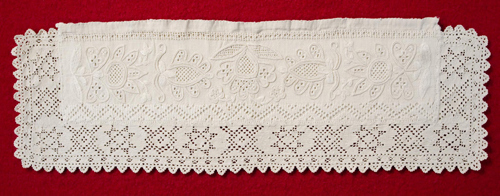In the exhibition two forms of collars are shown. We show the the older collars, unpicked from the womens shifts. We also show the removable collars used on different dresses. The collars on the shifts are normally rectangular. The variations in shape of the removable collars are telling us, when the collars are made.
Hedebo Embroidery and types of textiles
In the exhibition ”Hedebo Embroidery – a World of Variations” we have given priority to those textiles which as a whole provide the greatest insight in the development and composition of the most different variations of white embroideries all named Hedebo Embroidery.

Bridal shirt with counted thread work on shoulders, cuffs and front.
Bridal shirts
A number of shirts have been given to Greve Museum as bridal shirts. In the first half of the 19th century on the Heath it was a tradition to sew a special shirt with Hedebo Embroidery when a wedding was scheduled. The shirt was most often sewn by the future wife. After the wedding the shirt was used at special occassions.


Decorative towels
The decorative towels are about 35 cm in width and 150-170 cm long with two or three borders. On holidays and feasts the towels hang on the coloured, wowen curtains on the alcove in the Hedebo livingroom. The girls made the decorative towels when they passed their communion. The towels became a part of the trousseau. Some of the decorated towels were inherited.



"Knæduge"
A “knædug” is about 75 cm in width and 100 cm long. The textile is named from the pole, hanging over the oven in the livingroom of the peasants. In Danish this pole is called a “knæ”. It was used for drying socks. On holidays and feasts the pole was decorated with the embroidered “knædug”.



Post pieces
Behind the husband, sitting at the end of the long table, a cabinet with two twined posts was hanging on the wall. The post pieces were tied to the posts with two silk ribbons and are found in pairs – often with the monogram of the owner sewn on the one, and a year on the other.



Collars


